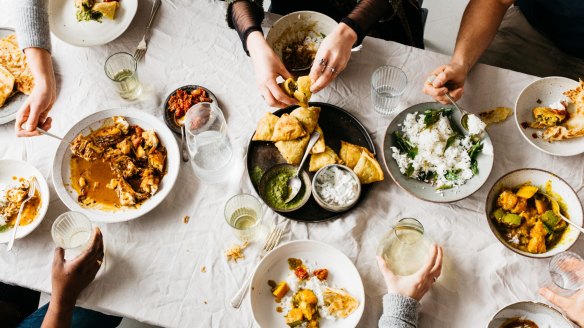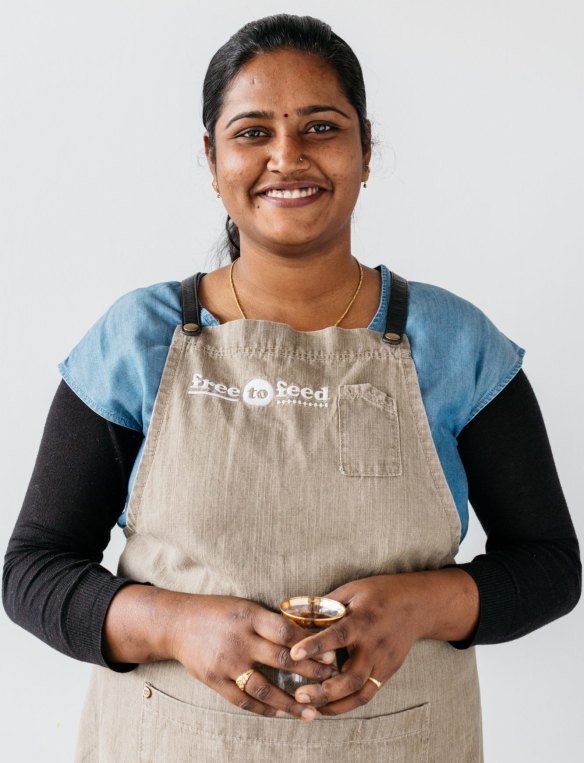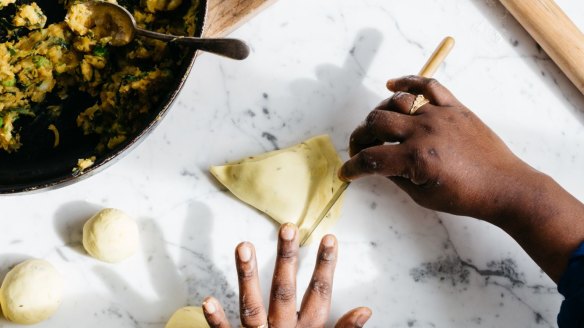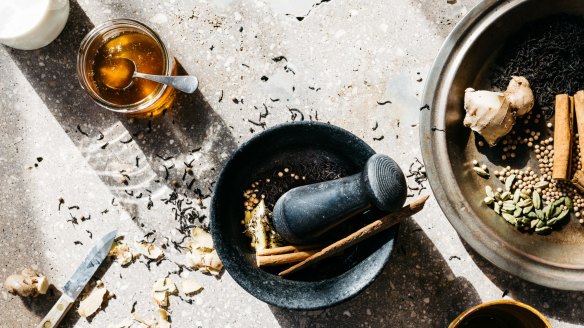Asylum seekers share stories and dishes at Free to Feed cooking classes

All good dinner parties need a raconteur, and Free to Feed has some of the best. These hosts have hard-won tales of threat, loss, corruption and new starts, the first-person stories relayed with humour and humility as the scent of spices hangs in the air.
Take Hamed, who fled Iran with his pregnant girlfriend to avoid the lash or a jail term. Or Nayran, forced to leave her home in Syria during the brutal civil war. Then there's Charu, who arrived at Christmas Island by boat with her two-year-old "because I wanted to see my son have a future".

Free to Feed, a not-for-profit social enterprise run by Loretta and Daniel Bolotin, has tapped into the global trend of "experiential dining", creating one-off events that give diners an interactive way to connect food with emotion.
As diners, you have the chance to ask questions you might be too shy to otherwise ask. "What was it like in detention?" one woman, a lawyer, asks curiously. "I had lots of friends there," Hamed says. "Officers from New Zealand. At night, they'd come and play us guitar and try to teach us English. If you open your door to be friends, they'll come, but some people close their door, to sleep. They don't eat, they just cry. They are very, very sad."
"If someone is sick, do they have a doctor?" another diner asks, and around it goes, all the while snacking on freshly baked flatbread and sipping sweet mint tea.
In the format of a cooking class, diners break naan while learning about one asylum seeker's culture, hearing their stories, cooking their traditional recipes, and sharing the dishes around a communal table.
"The best feedback we get is from participants," Loretta Bolotin says. "They love it. They want to connect and do something good. And food really helps."
Working with asylum seekers who already had cooking skills, Free to Feed has hosted more than 400 classes and events since it began in 2015. "Learning how to become a cooking class instructor is a challenging gig, especially if English is your second language," Loretta says. "It's about learning how to tell your story in an empowering way."
Free to Feed employs five cooks-in-residence, 10 casuals, and has about 40 volunteers.
As well as cooking classes, Free to Feed runs home experiences where an instructor can cook for up to 10 friends, and team-building cooking workshops.
"Refugees are often socially isolated from the new community they arrive in and can feel quite alone," Loretta says. "They have an extremely difficult time trying to find work, they don't know the job market, or whether the 10 years of experience running a restaurant in Iran is going to be recognised here."
Recently, Free to Feed received funding for Now to Launch, a program helping entrepreneurial refugees and migrants kickstart food businesses – eateries serving dishes straight from the streets of Colombo or Tehran.
"Research shows that refugees are risk-takers, they're enterprising, they're entrepreneurial," Loretta says. "We see so many good ideas. They are ready to start but might need some upskilling, or help with budgeting or exploring technology and how it can be leveraged."
When I visit Charu at Free to Feed's Thornbury HQ, mustard and fennel seeds are sizzling in the pan and she's rapidly chopping green chillies for eggplant and chickpea curry.
Charu learnt to cook from her grandmother and mother, who ran a restaurant in southern Sri Lanka.
"The eggplant curry is my grandmother's recipe but she used to make it with banana," she says.
"Loretta and Daniel are the best people," Charu says, "I'm very happy to visit these kind of people. It's improved my English and skills," she says.

Free to Feed cooking classes are $90 a head. Bookings at freetofeed.org.au.
Eggplant and chickpea curry
This Sri Lankan vegetarian curry is a favourite of Charu's family. The eggplants are deep-fried and golden, added to the curry late in the cook, allowing them to hold their shape.
INGREDIENTS
500g eggplant (about 2 large)
vegetable oil, for frying
2 tbsp coconut oil
1 brown onion, finely chopped
½ tsp black mustard seeds
½ tsp fennel seeds
5-6 curry leaves
1 green chilli, finely sliced
1 tomato, roughly chopped
2 tbsp ground turmeric
1 tbsp red chilli powder
1 tbsp ground coriander
50ml tamarind juice
2 cloves garlic, crushed
400g canned chickpeas, drained
200ml coconut milk
1 tbsp white sugar
large handful of coriander leaves and stalks, roughly chopped
METHOD
1. Remove the tops of the eggplants, discarding the stalk. Halve each eggplant widthways. Cut into two-centimetre slices, then into one-centimetre matchsticks.
2. Heat the vegetable oil to 180C in a large pot and fry the eggplant in batches until golden brown. Remove with a slotted spoon and drain on paper towel. Set aside.
3. Heat the coconut oil in a large pan over medium heat. Fry the onion, mustard seeds, fennel seeds and curry leaves for about three minutes, stirring frequently.
4. Tumble in the green chilli and tomato and stir to coat. Cook for 10 minutes, stirring occasionally, or until the tomatoes have collapsed.
5. Add the turmeric, chilli powder, ground coriander and tamarind and stir well. Add the garlic, pour in 200 millilitres of water, and stir. Allow to rapidly simmer for two to three minutes until the sauce thickens and becomes fragrant.
6. Add the chickpeas, coconut milk, sugar and fried eggplant. Stir, and check for seasoning, adding extra coconut milk if it's too spicy, or more sugar if it's too sour. Simmer for five minutes, transfer to a serving dish, and garnish with fresh coriander.
Serves 4

Vegetable samosas
"I used to make samosa in the restaurant," Charu says, who recommends serving them hot and golden with a coconut chutney.
INGREDIENTS
2 potatoes, peeled and roughly chopped
2 tbsp coconut oil
2 brown onions, finely chopped
1 long green chilli, roughly chopped
6 spring onions, sliced
1 cup curry leaves, loosely packed
½ tsp each ground coriander, cumin, red chilli powder and turmeric
1 tsp each salt and ground black pepper
½ cup frozen peas
¼ cup chopped coriander leaves
samosa dough (see recipe below)
plain flour, for dusting
vegetable oil, for frying
minted yoghurt, to serve
METHOD
1. Place the potatoes in a small saucepan and cover with water. Bring to the boil and cook until soft. Drain, set aside to cool, then use your hands to roughly crush the potato (you want the potato to be chunky, not mashed smooth).
2. Heat the coconut oil in a large pan over a medium to high heat. Fry the onion, green chilli, spring onions, curry leaves, spices, salt and pepper for about five minutes until the onion becomes translucent. Add the peas and potato and stir until the peas are warmed and cooked through. Remove from heat and stir in the chopped coriander leaves. Allow the mixture to cool completely.
3. Divide the dough into 10 equal portions. Form into balls, dust with flour and, using a rolling pin, roll the dough into circles about 15 centimetres in diameter. Using a sharp knife, cut each circle in half so you have 20 semicircles.
4. Place a heaped tablespoon of the samosa filling in the centre of each semicircle and fold the dough to enclose. Pinch the edges to seal.
5. Heat the oil to 180C. Fry samosas for about six to eight minutes, turning often so they are evenly browned. Drain on a paper towel and serve hot, with minted yoghurt.
Makes 20
Samosa dough
INGREDIENTS
2 cups plain flour
¼ tbsp ground turmeric
½ tsp sugar
1 tsp salt
1½ tbsp ghee
50ml coconut milk
METHOD
1. Combine flour, turmeric, sugar and salt in a large bowl. Mix well.
2. Add ghee and stir, then gradually add coconut milk, using clean fingers to rub the liquid into the flour, until a dough begins to form. Roll dough into a ball, cover and allow to rest for 20 minutes before using.
Makes Enough dough for 20 samosa

Chai tea
You can make this warming, spiced tea with any sort of milk you like but Charu's picks are cow's milk, soy milk or sweetened condensed milk.
INGREDIENTS
4 cups water
5cm piece ginger, grated
1 tbsp ground cardamom
3½ tbsp loose-leaf black tea
200ml milk
sugar (optional)
METHOD
1. Combine water, ginger and cardamom in a medium saucepan over a high heat and bring to the boil.
2. Add the tea leaves and boil for about five minutes until the liquid is dark brown. Strain, reserving the liquid and discarding the solids.
3. Combine the liquid with milk and sweeten with sugar if desired.
Makes 4 cups
Photos: Emily Weaving; styling: Stephanie Stamatis.
Restaurant reviews, news and the hottest openings served to your inbox.
Sign up